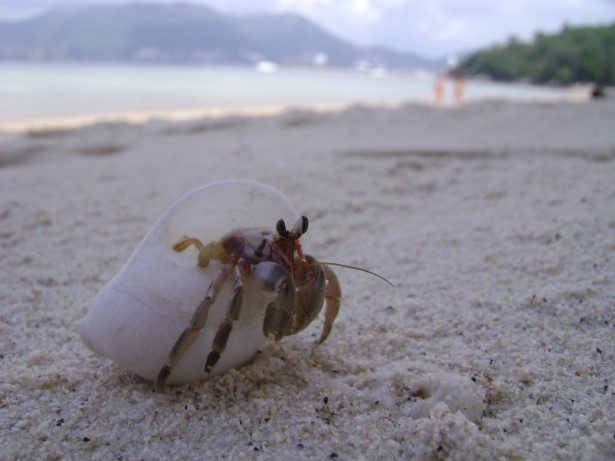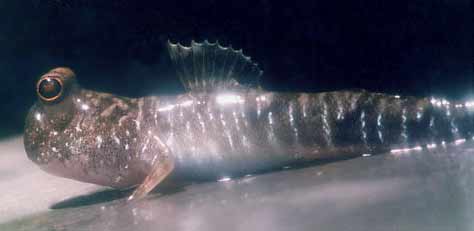To help my son in a school duty, I was reading about the genesis of the Moon. Fascinating.

([PD](https://commons.m.wikimedia.org/wiki/File:Earth%27s_Moon_from_NOAA.jpg))
The Moon was formed 4500 million years ago, shortly after the formation of the solar system, in a gigantic collision: the Earth was hit by an object the size of Mars, that is to say approximately half of the terrestrial radius and 10% of its mass.
That early planet is named Theia, who according to Greek mythology was the mother of the moon goddess Selene. Theia orbited around the Sun in the same orbit as the Earth, but separated by a certain angle, near one of the _Lagrange points_ known as L4 or L5.

([CC BY-SA 3.0](https://commons.m.wikimedia.org/wiki/File:Pt.lagrange.jpg), by Besnier.m)
The Lagrange points are stable points of the Earth-Sun system, where planetary garbage that does not fall on any of these celestial bodies can accumulate. Theia was formed at one of these points, from rocks and dust that did not fall to Earth during its genesis, and survived there.
Eventually, a passage near Venus destabilized Theia, who approached the Earth and catastrophically impacted it. The impact ripped off a piece of the Earth and horribly warmed the planet, vaporizing and/or melting much of its crust. The uprooted piece orbited very close to the Earth and began to accumulate some of the detached material, becoming the Moon.

([PD](https://es.m.wikipedia.org/wiki/Archivo:Artist%27s_concept_of_collision_at_HD_172555.jpg))
It is fascinating how much can we know about a collision that occurred 4500 million years ago, using only geological and selenological evidence.
* The Earth's axis of rotation and that of the lunar orbit are very similar, that is proof of the common origin of both bodies in a single impact.
* We know the angle of the impact, because it can be deduced from the tilt of these axes with respect to the Earth's orbit, which incidentally is the cause of the seasons.
* We know the approximate radius of Theia, because that explains the amount of rotation (_angular momentum_) of the Earth-Moon system.
* We know that the collision did not completely vaporize our planet, because the heavy elements (iron, nickel) remained on Earth, while very little of them can be found now on the Moon.
* For the collision not to completely vaporize the planet, the speed of the impact must have been relatively slow, less than 5km/s. That implies that Theia had an orbit very similar to that of the Earth. Such an orbit is only possible if it was near a Lagrange point.
* However, we also know that the impact vaporized part of the Earth's crust, because there are almost no volatile elements on the Moon.
* A very interesting detail is that part of the vaporized material (mainly silicon) formed a hot atmosphere common to both bodies. The earth and lunar crust captured that ancient atmosphere, resulting in a similar composition (_isotopic ratios_).
Initially the Moon was much closer to the Earth. In the near face the terrestrial gravity was much stronger than in the distant one. This _tidal force_ caused the heaviest face of the Moon to be always looking towards the Earth.
As the Moon cooled, the tidal force caused fractures on its surface, bringing out lava from its interior. These cracks were more frequent in the near face, where the attraction of the Earth was stronger. That's why that face is covered with _maria_: the gray spots on the Moon, which we call _"seas"_, are actually outcrops of lava, already cold, caused by that process.

([CC BY-SA 3.0](https://commons.m.wikimedia.org/wiki/File:Moon_names.svg#mw-jump-to-license), by Peter Freiman)
Tidal forces deform both bodies, knead them. In this process, they dissipate energy, transforming it into heat. That process slows down the Moon. And as it slows down, it moves away from the Earth (because the _third law of Kepler_ is satisfied). Eventually in the future, it will escape. Selene, Theia's daughter, will thus gain the freedom she never had since her tragic birth.

([PD](https://commons.m.wikimedia.org/wiki/File:Tide_animation.gif))
As a species, we are fortunate to have the Moon so close to us. The Moon was the cause of many crucial facts of our existence
* The gravity of the Moon causes the tides. In the distant past, tides left algae on beaches. These algae eventually evolved to colonize the continents, transforming into terrestrial plants.

([CC BY-SA 3.0](https://commons.m.wikimedia.org/wiki/File:Algas_en_la_Playa_El_Rafal.JPG), by mabelcalabuig)
* Similarly, the tides left traps on the beaches, animals similar to shrimp and crabs. These evolved into terrestrial insects.

([PD](https://www.publicdomainpictures.net/en/view-image.php?image=87334&picture=crab-on-beach))
* Finally, in more recent times the tides left fish on the beaches. These fish developed legs and the ability to breathe air... and here we are, the result of the evolution of terrestrial vertebrates.

([CC BY-SA 3.0](https://commons.m.wikimedia.org/wiki/File:Periophthalmus_gracilis.jpg#mw-jump-to-license), by Gianluca Polgar)
* Our prehistoric ancestors were curious. As they looked up at the sky they started to wonder what that brilliant disc was that illuminated the night, and why it had phases and eclipses. And trying to answer that question, they invented what we call _science_ today.

([CC BY-SA 3.0](https://en.m.wikipedia.org/wiki/File:Neanderthal-2D-MJC.jpg), from Wikimedia)
* Scientific progress will eventually lead us to colonize the solar system. To do this, we will almost certainly start with the Moon. Because of its proximity and low gravity, the Moon is ideal as a port, to receive and send ships, with supplies and settlers, to other planets.

([PD](https://commons.m.wikimedia.org/wiki/File:Entering_a_Lunar_Outpost.jpg#mw-jump-to-license))
Thus, human beings exist, evolve, and will hopefully survive, thanks to the existence of the Moon.
The apotheothic destruction of Theia was a fortunate catastrophe.
----
## Post scriptum: _disneylands_
[This](http://blogs.discovermagazine.com/d-brief/2017/10/19/moon-settlers-cave/#.XAKlp5nQ9-E) is **excellent** news. There really are _disneylands_ on the Moon, i.e. huge inhabitable underground caverns.
The Moon is a lucky accident. A celestial body close to the Earth, with abundant light and gravity high enough to be able to inhabit it comfortably, and at the same time low enough to be able to get to orbit without using rockets, with electromagnetic catapults. It is a natural port. A populated Moon would be our starting point for the rest of the solar system. Something very difficult to do directly from Earth.
But it is a natural accident, not a blessing from God. Populating it is not easy at all, more than anything because of its absence of magnetic field. Except when we see a compass, the rest of the time we don't think about the Earth's magnetic field. But it is a fundamental element that guarantees that we still alive.
The magnetic field deflects the solar wind towards the poles, causing the auroras borealis, and preventing that radiation from reaching us. Without a magnetic field, the solar wind radiation would reach the ground and be lethal. The onslaught of the solar wind is so strong that even on Mars, where it is much weaker, it dragged much of the atmosphere into space. I don't know if we could have evolved without the shield that the magnetic field gives us.

([PD](https://es.m.wikipedia.org/wiki/Archivo:Structure_of_the_magnetosphere-es.svg))
The moon has no magnetic field. The solar wind reaches the ground. We could tolerate it for a few days. Even for a lifetime. But not for generations. That's why human settlements on the Moon must be underground (at least until we have gigantic superconducting magnets that can generate an artificial field).
It was always suspected that the Moon had underground caverns the size of cities. Science fiction author John Varley calls them _disneylands_ in his stories of _The Eight Worlds_ (which I recommend, read for example the excellent novels _The Golden Globe_ or _Steel Beach_ or the tales of _Blue Champagne_). This news is confirmation that they do exist, and that we won't have to dig the rock to build shelters. It is excellent.

([PD](https://en.m.wikipedia.org/wiki/Space_station))
Once again, Theia's spectacular death insists on being a fortunate catastrophe.

My posts (mostly in spanish) are published in
* [Cave Canem](http://attentialcane.blogspot.com) (science, opinion)
* [Literatops](http://literatops.blogspot.com) (literature, literary quotes)
* [Diaspora*](https://despora.de/u/severianx)
* [Mastodon](https://mastodon.cloud/web/accounts/100673)
* [SteemIt](https://steemit.com/@severianx)
* [Reddit](https://www.reddit.com/user/Severianes)
* [Facebook](https://m.facebook.com/severianX)
* [Telegram](http://t.me/SeverianX)
* [Tumblr](http://severianx.tumblr.com)
I can also be contacted in
* [XMPP](xmpp:severianx@xabber.org) SeverianX
* [Discord](discordapp.com) SeverianX#6874
* [SteemChat](https://steem.chat) SeverianX
* [CuriousCat](https://curiouscat.me/severianx)
* [e-mail](mailto:severianus@gmail.com)